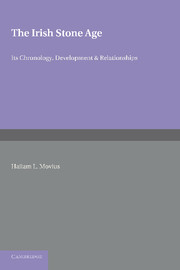Book contents
- Frontmatter
- Dedication
- Contents
- ILLUSTRATIONS
- FOREWORD
- PREFACE
- INTRODUCTION
- Part One THE CHRONOLOGY OF THE LATE-GLACIAL AND EARLY POST-GLACIAL PERIODS IN NORTHERN AND WESTERN EUROPE
- Part Two THE STONE AGE CULTURES OF IRELAND
- Appendices I-VI
- APPENDIX I The Raised Beach of the Third Interglacial Period
- APPENDIX II Deposits of the Interstadial Period between the Old and the New Drift Glaciations (W1/W2) in England and Scotland
- APPENDIX III The New Drift Glaciation
- APPENDIX IV The Recession of the Last Ice-Sheets
- APPENDIX V Deposits of the Late-Glacial Sea
- APPENDIX VI Submerged Forests and Raised Beaches in Britain and Ireland
- REFERENCES CITED IN THE TEXT
- CLASSIFIED LIST OF REFERENCES TO CAVE RESEARCH AND STONE AGE ARCHAEOLOGY IN IRELAND
- ADDENDUM
- INDEX
APPENDIX II - Deposits of the Interstadial Period between the Old and the New Drift Glaciations (W1/W2) in England and Scotland
from Appendices I-VI
Published online by Cambridge University Press: 05 June 2016
- Frontmatter
- Dedication
- Contents
- ILLUSTRATIONS
- FOREWORD
- PREFACE
- INTRODUCTION
- Part One THE CHRONOLOGY OF THE LATE-GLACIAL AND EARLY POST-GLACIAL PERIODS IN NORTHERN AND WESTERN EUROPE
- Part Two THE STONE AGE CULTURES OF IRELAND
- Appendices I-VI
- APPENDIX I The Raised Beach of the Third Interglacial Period
- APPENDIX II Deposits of the Interstadial Period between the Old and the New Drift Glaciations (W1/W2) in England and Scotland
- APPENDIX III The New Drift Glaciation
- APPENDIX IV The Recession of the Last Ice-Sheets
- APPENDIX V Deposits of the Late-Glacial Sea
- APPENDIX VI Submerged Forests and Raised Beaches in Britain and Ireland
- REFERENCES CITED IN THE TEXT
- CLASSIFIED LIST OF REFERENCES TO CAVE RESEARCH AND STONE AGE ARCHAEOLOGY IN IRELAND
- ADDENDUM
- INDEX
Summary
During the period between the retreat of the Old Drift Ice-Sheets and the subsequent New Drift advance interstadial deposits were formed in Britain and Ireland. In many cases these consist only of sands and gravels which contain very few organic remains, but in addition peat and clay beds, yielding such valuable climatic indicators as pollen and molluscs, occur. “Interval” deposits of this period are known in East Anglia—at Ipswich and The Traveller's Rest Pit, Cambridge (Fig. 4, p. 35)—where interglacial soils overlie the Upper Chalky Boulder Clay (MacClintock, 1933, pp. 1047-9). In the north of England, in the Brampton district, Trotter and Hollingworth (M.G.S. England and Wales, 1932, p. 146) have established the presence of sands, gravels and laminated clays above the boulder clay of the Early Scottish Glaciation, and in Northumberland (Woolacott, 1921, p. 25) and West Yorkshire (Raistrick, 1933, p. 264) similar deposits are reported. The same is true of North-East Scotland (Bremner, 1934[a], p. 55) North-East Ireland (Dwerryhouse, 1923, p. 421) and the coastal portion of County Wicklow (Farrington, 1931, p. 218). In addition to these deposits there is along the coast of Eastern England from Norfolk to Durham abundant evidence demonstrating a marine transgression during the period under discussion (Harrison, 1935). This is known as the March-Nar submergence. At several Idealities important data have been secured. In the peat layer, Deposit 4, at Kirmington (Fig. 4, p. 35; for section see p. 31) Dr G. Erdtman has identified the following flora: Alnus, Betula, Pinus, Picea, Quercus, Ulmus, Tilia, Ilex, Fraxinus (?) and Corylus, indicating a temperate climate at the time of formation of this bed of no greater severity than that of Lincolnshire to-day (Burchell, 1935, p. 327).
Cardium edule, Mactra subtruncata and Mytilus edulis in an undisturbed condition (Wright, 1937, p. 87). Thus during this period the sea transgressed this portion of the east coast, and since there is a layer of Hessle Boulder Clay above, these deposits must surely date from the interval between the Old and the New Drift. The Kirmington evidence is substantiated in County Durham.
- Type
- Chapter
- Information
- The Irish Stone AgeIts Chronology, Development and Relationships, pp. 266 - 269Publisher: Cambridge University PressPrint publication year: 2013



